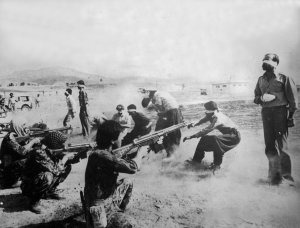Nick Charles: In addition to the hostage crisis, Iran had its own internal problems. First, trying to establish a new government and then fighting off a threat from its next door neighbor Iraq.
There were sporadic border clashes most of the year, but the fighting became heavy in September when the Iraqi government reported that its troops entered Ahwaz, the capital of Iran's Kurdistan province and its troops were on the way to the oil port of Khorramshahr.
On September 28, the UN Security Council adopted a resolution urging Iran and Iraq to stop the fighting and accept mediation. But Iran turned to deaf ear to the United Nations resolution saying its forces would continue to fight until all Iraqi troops were withdrawn from Iranian territory. So the fighting went on. By the first week in October, Jordan decided to take sides, mobilizing all transport vehicles to carry food and supplies to the Iraqis.
On October 11, the Iraqi troops began moving towards the Iranian refining complex at Abadan. On the following day, Iraq cut diplomatic relations with Libya and Syria accusing them of sending military equipment to Iran. The Middle-East was now split as a result of the Persian Gulf War.
United States fearful that oil supplies to the West would be cut as a result of the fighting, set a guided missile cruiser to the troubled region and before long, 31 US Naval ships were in the Arabian Sea and the Persian Gulf areas to keep a careful eye on the situation.
Washington warned Moscow to stay clear and Moscow warned Washington to keep hands off. So the two major powers were now involved protecting their interests.
Syria and Jordan on opposite sides of the fence had the Persian Gulf War affect their own relations as tensions began to grow in the border area, but Saudi Arabia acting as intermediary defused that situation and by the middle of December, both sides began withdrawing their forces.











